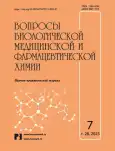Содержание нейропептидов в плазме крови крыс Вистар после субхронического низкодозового воздействия ацетатом ртути
- Авторы: Щепеткова К.М.1, Батоцыренова Е.Г.1,2, Кашуро В.А.1,3,4, Крецер Т.Ю.1
-
Учреждения:
- Санкт-Петербургский государственный педиатрический медицинский университет
- Научно-клинический центр токсикологии им. акад. С.Н. Голикова Федерального медико-биологического агентства
- Российский государственный педагогический университет им. А.И. Герцена
- Санкт-Петербургский государственный университет
- Выпуск: Том 28, № 7 (2025)
- Страницы: 90-97
- Раздел: Статьи
- URL: https://journals.eco-vector.com/1560-9596/article/view/687969
- DOI: https://doi.org/10.29296/25877313-2025-07-11
- ID: 687969
Цитировать
Полный текст
Аннотация
Введение. Ртуть относится к кумулятивным ядам, то есть имеет способность накапливаться в тканях и органах, что негативно отражается на работе систем организма. Одним из органов-мишеней для ртутных соединений является головной мозг.
Цель исследования – изучение содержания нейропептидов в плазме крови крыс после субхронического низкодозового отравления ацетатом ртути.
Материал и методы. На 30-й и 44-й день после 30-дневного ежедневного внутрижелудочного введения ацетата ртути в дозе 4 мг/кг в плазме крови крыс Вистар определяли содержание кальций-связывающего белка (S100), глиального фибриллярного кислого протеина (GFAP), нейронспецифической енолазы (NSE), пигментного фактора эпителиального происхождения (PEDF), основного белка миелина (MBP).
Результаты. В проведенном исследовании выявлено достоверное снижение концентрации белка S100 в плазме крови опытной группы крыс на 43,9%, а также достоверное повышение концентрации МВР на 172,6% после 30-дневного введения ацетата ртути. Через 14 дней после окончания введения токсиканта в плазме крови опытных животных концентрация белка S100 была достоверно ниже на 132,7% по сравнению с контрольной группой. Отмечалось статистически значимое увеличение содержания МВР – на 59,4% и нейронспецифической енолазы – на 44,6% по сравнению с контрольной группой. Концентрация нейропептидов PEDF и GFAP после интоксикации ацетатом ртути изменялась незначительно.
Выводы. Полученные данные показывают, что даже при низких дозах поступления ацетата ртути в организм, но в течение длительного времени, такое воздействие оказывает значительное влияние на концентрацию нейропептидов в плазме крови крыс, что может вызывать негативные изменения в центральной нервной системе.
Ключевые слова
Полный текст
Об авторах
К. М. Щепеткова
Санкт-Петербургский государственный педиатрический медицинский университет
Автор, ответственный за переписку.
Email: tesh_07@inbox.ru
ORCID iD: 0000-0002-8250-4178
SPIN-код: 2788-9060
аспирант
Россия, 194100, г. Санкт-Петербург, ул. Литовская, 2Е. Г. Батоцыренова
Санкт-Петербургский государственный педиатрический медицинский университет;Научно-клинический центр токсикологии им. акад. С.Н. Голикова Федерального медико-биологического агентства
Email: bkaterina2009@yandex.ru
ORCID iD: 0000-0003-3827-4579
SPIN-код: 5800-7966
доктор биологических наук, доцент, зав. кафедрой, вед. науч. сотрудник
Россия, 194100, г. Санкт-Петербург, ул. Литовская, 2; 192019, Санкт-Петербург, ул. Бехтерева, д. 1В. А. Кашуро
Санкт-Петербургский государственный педиатрический медицинский университет; Российский государственный педагогический университет им. А.И. Герцена; Санкт-Петербургский государственный университет
Email: kashuro@yandex.ru
ORCID iD: 0000-0002-7892-0048
SPIN-код: 3821-8062
доктор медицинских наук, доцент, зав. кафедрой
Россия, 194100, г. Санкт-Петербург, ул. Литовская, 2; 191186, Санкт-Петербург, набережная реки Мойки 48; 199034, Санкт-Петербург, Университетская наб., д. 7–9Т. Ю. Крецер
Санкт-Петербургский государственный педиатрический медицинский университет
Email: tkropotova@mail.ru
ORCID iD: 0000-0002-8713-9704
SPIN-код: 4456-3891
доцент
Россия, 194100, г. Санкт-Петербург, ул. Литовская, 2Список литературы
- Вертинский А.П. Проблемы загрязнения окружающей природной среды Российской Федерации тяжелыми металлами. Инновации и инвестиции. 2020; 1: 232–237. doi: 10.1051/e3sconf/202124401006.
- Li F., Ma C., Zhang P. Mercury deposition, climate change and anthropogenic activities: A review. Frontiers in Earth Science. 2020; 8: 316. doi: 10.3389/feart.2020.00316.
- Гладышев В.Б. Токсичные свойства ртути и ее влияние на организм животных и человека. The Scientific Heritage. 2021; 81(2): 16–22. doi: 10.24412/9215-0365-2021-81-2-16-22.
- Carocci A., Rovito N., Sinicropi M.S. et al. Mercury toxicity and neurodegenerative effects. Rev. Environ. Contam. Toxicol. 2014; 229: 1–18. doi: 10.1007/978-3-319-03777-6_1.
- Chakraborty P. Mercury exposure and Alzheimer's disease in India-An imminent threat? Science of the Total Environment. 2017; 589: 232–235. doi: 10.1016/j.scitotenv.2017.02.168.
- Скальный А.В., Астраханцева Е.Ю., Скальная М.Г. и др. Социоэкономические эффекты влияния токсичных металлов на психо-интеллектуальное здоровье детей и подростков. Микроэлементы в медицине. 2017; 18(3): 3–12. doi: 10.19112/2413-6174-2017-18-3-3-12.
- Батоцыренова Е.Г., Вакуненкова О.А., Золотоверхая Е.А. и др. Показатели антиоксидантной системы в отдаленный период после острого отравления нитратом ртути в эксперименте. Токсикологический вестник. 2020; 2: 36–41. doi: 10.36946/0869-7922-2020-2-35-40.
- Щепеткова К.М., Батоцыренова Е.Г., Литвиненко Л.А. и др. Антиоксидантная система и перекисное окисление липидов в эритроцитах крыс при низкодозовом воздействии ацетатом ртути. Педиатр. 2022; 13(2): 25–34. doi: 10.17816/PED13225-34.
- Graves S.I.; Baker D.J. Implicating endothelial cell senescence to dysfunction in the ageing and diseased brain. Basic and Clinical Pharmacology and Toxicology. 2020; 127(2): 102–110. doi: 10.1111/bcpt.13403.
- Белобородова Н.В., Дмитриева И.Б., Черневская Е.А. Диагностическая значимость белка s100b при критических состояниях. Общая реаниматология. 2011; 6: 72–76. doi: 10.15360/1813-9779-2011-6-72.
- Rai A., Maurya S.K., Sharma R. et al. Down-regulated GFAPα: a major player in heavy metal induced astrocyte damage. Toxicology Mechanisms and Methods. 2012; 23(2): 99–107. doi: 10.3109/15376516.2012.721809.
- Abooshahab R., Dass C.R. The biological relevance of pigment epithelium-derived factor on the path from aging to age-related disease. Mechanisms of Ageing and Development. 2021; 196: 111478. doi: 10.1016/j.mad.2021.111478.
- El-Fawal H.A. Neuroantibody biomarkers: links and challenges in environmental neurodegeneration and autoimmunity. Autoimmune Diseases. 2014; 1: 340875. doi: 10.1155/2014/340875.
- Golmohammadi J., Jahanian-Najafabadi A., Aliomrani M. Chronic Oral Arsenic Exposure and Its Correlation with Serum S100B Concentration. Biological Trace Element Research. 2018; 189: 172–179. DOI:.10.1007/s12011-018-1463-2.
- Рукавишников В.С., Лахман О.Л., Соседова Л.М. и др. Токсические энцефалопатии в отдаленном постконтактном периоде профессиональных нейроинтоксикаций (клинико-экспериментальные исследования). Медицина труда и промышленная экология. 2010; 10: 22–30.
- Соседова Л.М., Кудаева И.В., Титов Е.А. и др. Морфологические и нейрохимические эффекты в отдаленном периоде ртутной интоксикации (экспериментальные данные). Медицина труда и промышленная экология. 2009; 1: 37–42.
- Kister A., Kister I. Overview of myelin, major myelin lipids, and myelin-associated proteins. Frontiers in Chemistry. 2023; 10: 1041961. doi: 10.3389/fchem.2022.1041961.
- Branca J.J.V., Fiorillo C., Carrino D. et al. Cadmium-Induced Oxidative Stress: Focus on the Central Nervous System.
- Швецов А.В., Дюжикова Н.А., Савенко Ю.Н. и др. Влияние экспериментальной комы на экспрессию белка bcl-2 и каспаз-3, 9 в мозге крыс. Бюллетень экспериментальной биологии и медицины. 2015; 160(8): 178–181. doi: 10.1007/s10517-015-3132-1.
- Щепеткова К.М., Батоцыренова Е.Г., Шустов Е.Б. и др. Влияние этомерзола фумарата на когнитивные функции крыс при отравлении ацетатом ртути. Биомедицина. 2023; 19: 124–129. doi: 10.33647/2713-0428-19-3E-124-129.
Дополнительные файлы






